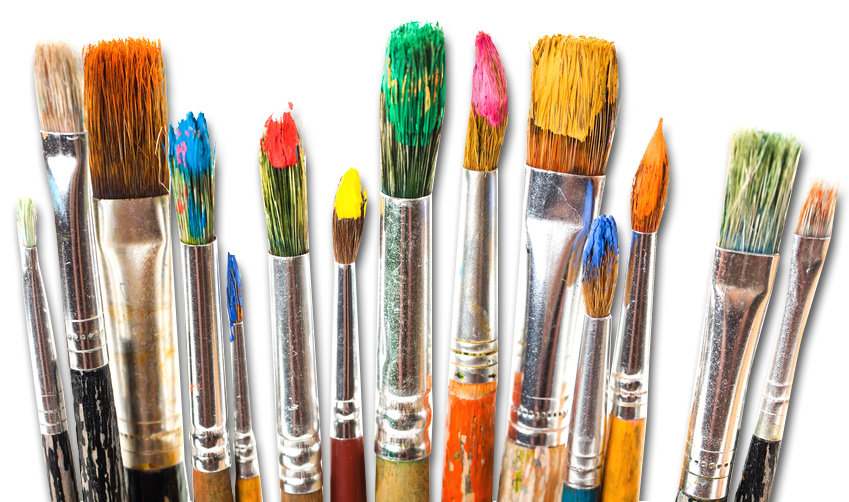[ad_1]
Oil painting brushes come in a wide variety of sizes and shapes and this can sometimes overwhelm a beginner. This article will provide you with an overview of the various oil painting brushes available and help you decide what kind of brushes you should invest in.
BRUSH TEXTURES
Oil painting brushes come in two different textures basically, and they are classified as hard and soft. Hard brushes are generally referred to as “bristle brushes” and they are quite resilient. Hard brushes are made from hog’s hair and they are strong and stiff. They will hold a good amount of paint and can handle the oil painting medium quite well. I personally prefer working with bristle brushes exclusively as I tend to paint rather rough and direct.
Soft oil painting brushes are made from softer hairs that come from animals like sable, squirrel, or mongoose. Softer brushes will generally give your painting a softer smoother appearance and are more often used for finishing or detailed work. Sable brushes are the most expensive usually but there are synthetic brushes made of nylon that are very good substitutes for sable. They are more resilient and cheaper than sable.
BRUSH SHAPES
There are five shapes to brushes that are generally used and each is meant to have its own function. I prefer to paint with flats, brights and fliberts of various sizes, and only occasionally make use of the other shapes. This is my preference and you will certainly develop your own the longer you paint with oils.
Flats
Flat oil painting brushes have a wide square end with medium to long hairs. Flat brushes generally have a lot of spring to them and can hold a lot of paint. You can use these brushes for broad sweeping strokes or you can turn the brush on its edge to create fine lines. Flat brushes are great for earlier stages of a painting when you are blocking in large areas.
Brights
Bright oil painting brushes are similar in shape to flat brushes but the hairs are shorter. They are best used for making shorter controlled strokes. They do not hold nearly as much paint as a flat brush.
Filbert
The filbert is also similar to the flat brush only the edge of the brush comes to a rounded shape. The hairs of the filbert are medium to long in length. This rounded shape will give you more control then a bright. The filbert is great for blending and figurative work.
Rounds
A round oil painting brush has a round or pointed tip. They hold a nice amount of paint and are great for making thin or thick lines. Use this brush for dabbing on dots or blotches of color. Round brushes are also good for washes, fills and detailed work. They are not suited for creating hard straight edges.
Fans
The fan oil painting brush is a flat fan shaped brush. The fan brush is a specialized brush. It is either used very often by the artist or not at all. It really depends on your style of painting. This brush is not qualified for holding paint. It is used more often for blending colors and you should keep this brush clean and dry if you plan to do a lot of blending during a session. The brush will begin to lose its effectiveness when it becomes filled with paint. You may want to keep a few extras on hand.
BRUSH SIZE
Oil painting brushes come in a variety of sizes indicated by numbers as in 1,2,4,6,8,10; size 1 being the smallest and 10 the largest in this example.
BRUSH MANUFACTURERS
Oil painting brushes are made by a number of different manufacturers. A few of the more popular brands are Winsor & Newton, Silver Brush and Robert Simmons. Some artists prefer one brand over another. Other artists like to have an assortment of different brands available. The only way you will know what you like best is by working with the brushes yourself.
CARING FOR YOUR BRUSHES
No matter what brush you buy, whether they are top of the line expensive brushes, or cheaper ones, you will definitely get more life out of them if you care for them properly. There seems to be a difference of opinion when it comes to brush care, especially when it comes to drying your brushes. I personally have two products on hand for cleaning and conditioning my brushes: Masters Brush Cleaner and Preserver and Mona Lisa Pink Brush Soap. I have found that the Masters Brush Cleaner works great on brushes that are deeply stained and hardened with paint, that I would have otherwise thrown out. I use the Mona Lisa Pink Brush Soap to clean my brushes right after a painting session. These cleaners will also help condition your brushes.
After washing my brushes with either of these cleaners, I then attach a clothes pin to the handle of the brush and rest the clothes pin on the edge of a counter or table so that the brush is hanging with the bristles pointing towards the floor. Gravity then pulls the moisture from the brush so that it does not collect in the ferrule, which can damage a brush over time.
[ad_2]

